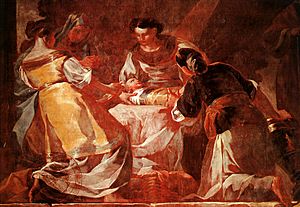Frescoes in the Cartuja de Aula Dei facts for kids
Quick facts for kids Cycle of the Life of the Virgin: Frescoes in the Cartuja de Aula DeiThe Birth of the Virgin (detail) |
|
|---|---|
| Spanish: Ciclo pictórico de la Vida de la Virgen de la Cartuja del Aula Dei | |
 |
|
| Artist | Francisco Goya |
| Year | 1774 |
| Type | Oil mural |
| Dimensions | 306 cm × 790 cm (120 in × 310 in) |
| Location | Charterhouse of Aula Dei, near Zaragoza |
The Frescoes in the Cartuja de Aula Dei are a group of amazing wall paintings created by the famous artist Francisco de Goya in 1774. These paintings are called "frescoes" because they are painted directly onto the walls of the church at the Charterhouse of Aula Dei. This monastery is located near Zaragoza, in Aragon, Spain. Goya used a special technique called secco, which means he painted with oils directly onto the dry wall surface. The artworks tell the story of the Life of the Virgin Mary.
Contents
How Goya Painted These Frescoes
After a learning trip to Italy, Goya started getting many requests to paint frescoes. One important job was for the Basílica del Pilar in Zaragoza. There, he painted a work called Adoration of the Name of God.
Why Goya Painted at Aula Dei
Another big project was for the church of the Charterhouse of Aula Dei. Goya's brother-in-law, Manuel Bayeu, was a monk there. This connection likely helped Goya get the job. He was asked to create a series of paintings about the Life of the Virgin Mary. He finished these paintings in 1774.
Goya's Skill in Large-Scale Art
In this project, Goya showed how good he was at painting huge murals. Each scene he painted was very large, some measuring between five and ten meters long. They were also one to three meters tall. These paintings covered almost all the inside walls of the church.
What Happened to the Paintings Over Time
Originally, there were eleven paintings in the series. However, only seven of them remain today. The monastery was abandoned between 1835 and 1837. This happened because the government took over church properties, a process called Desamortizacion.
Restoring the Damaged Artworks
Because the monastery was left empty, four of the original paintings were badly damaged. They had to be repainted in 1903 by two brothers, Paul and Amedée Buffet. This happened after the Carthusian Order bought the monastery back in 1901. The seven paintings that survived also suffered from years of neglect. They were carefully restored between 1978 and 1979 to bring them back to life.
What the Frescoes Show
Goya started working on these frescoes in 1773. He was asked to do this by Brother Félix Salcedo and Brother José Lalana. The paintings show different moments from the life of the Virgin Mary. They are arranged like a long picture story around the church walls.
The Story of the Virgin Mary in Art
The series begins with a painting of Joachim and Anne, who were Mary's parents. This painting is located above the main doors of the church. After that, the paintings switch between scenes from the Gospels and from the Epistles.
Key Scenes in the Series
To the right of the entrance, you can see the Birth of the Virgin. To the left, there is the Marriage of the Virgin. Other paintings in the series include the Visitation of Mary to her cousin Elizabeth, the Circumcision, and the Adoration of the Magi. The last original work by Goya that remains is the Presentation of Jesus at the Temple.
See also
 In Spanish: Pinturas de la Cartuja del Aula Dei para niños
In Spanish: Pinturas de la Cartuja del Aula Dei para niños
- List of works by Francisco Goya

